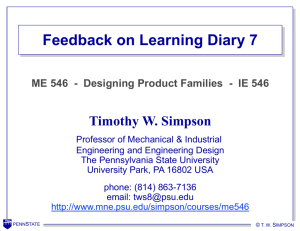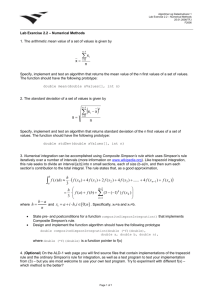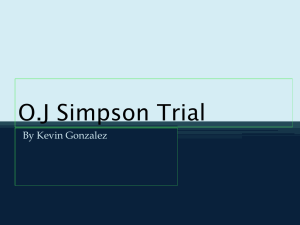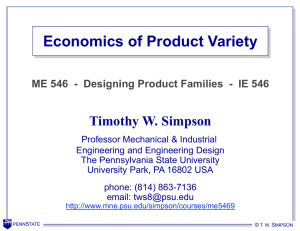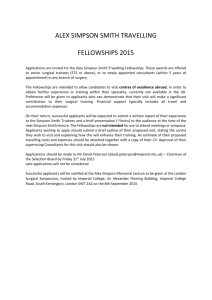PPT
advertisement
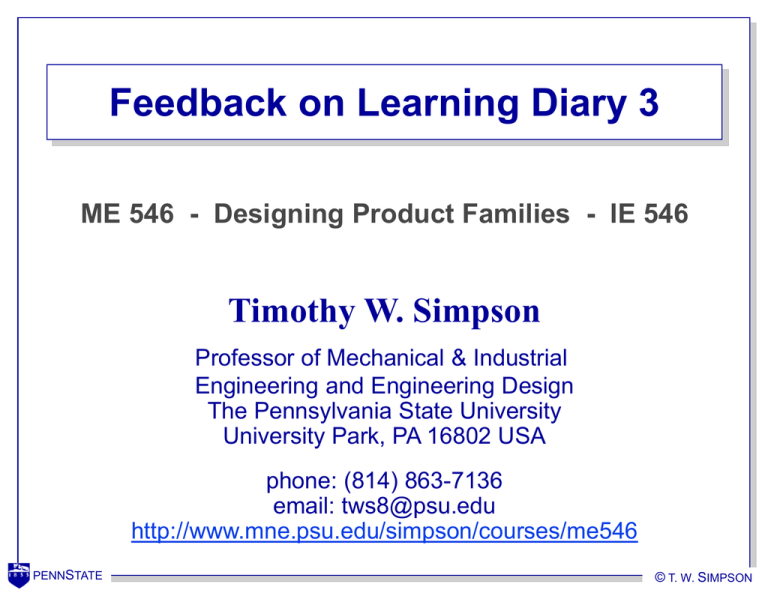
Feedback on Learning Diary 3 ME 546 - Designing Product Families - IE 546 Timothy W. Simpson Professor of Mechanical & Industrial Engineering and Engineering Design The Pennsylvania State University University Park, PA 16802 USA phone: (814) 863-7136 email: tws8@psu.edu http://www.mne.psu.edu/simpson/courses/me546 PENNSTATE © T. W. SIMPSON Grade Distribution • Scores continue to improve Diary 1 2 3 4 5 #1 0 8 15 8 1 #2 0 1 22 11 2 #3 0 0 18 16 2 25 Diary 1 (Avg = 2.51) Diary 2 (Avg = 3.13) Diary 3 (Avg = 3.56) • As a class, average is increasing s1=1.39 s2=1.04 s3=0.61 # Responses 20 15 10 5 0 Grade 1 PENNSTATE 2 3 4 5 © T. W. SIMPSON A Shift in Focus? • Each time we review the latest learning diary, Dr. Simpson displays examples of what he felt were important topics and generally explained why he felt this way. What I’ve found particularly interesting is actually something of an evolution of the assignment and the examples which Dr. Simpson felt worth including absent of the topic. During the discussion of the first learning diary Dr. Simpson posted several examples. The heading of each corresponded to a grade for the assignment. This was a means to instruct the class as to the level of detail and quality of work expected for each assignment. During the discussion of the second assignment, Dr. Simpson did not sort each assignment based upon quality or grades. Instead he preferred to focus and sort the work based upon the topics each paper discussed. In doing so the focus of the assignment went from sorting based upon the hierarchy of grade to sorting based upon ideas. The context of the discussion therefore shifted to focus more on ideas giving the class an opportunity to reflect on the work of each other produced. I felt as though this was a shift away from grades and towards learning. … This discussion provides more substance because the focus has now shifted. PENNSTATE © T. W. SIMPSON The Less Obvious Option • I would like to focus on what we did the morning we handed in the assignment. Traditionally in class we would have two options. The first of which is to walk through the questions and have the class answer them as a group. This would be long and more than likely boring as well. The second obvious options is for Dr. Simpson to lead a discussion were we talk about the major points of each company so that everyone has a general understating of the topics. Instead our class pursued a third less obvious option. We instead gathered in groups to discuss each company. But rather than just sit around and try and answer a few canned questions or give a summary of our company, we were given a much more challenging assignment. Here we were asked to compare and contrast 8 companies. … Ironically enough, out of such a straight forward assignment, essentially to compare and contrast, we gained 4 different style answers from 4 separate groups. Each group tackled the assignment differently. For instance one group decided to break down company by company and compare difference and similarities. Another group looked for commonalities between some companies while excluded others. Our group in contrast sought to pursue generalities and underlying themes between companies. Some groups offered ideas they thought were commonalities while others through they were differences. Each group provided new insight and a different perspective to the presentation. These gains far exceeded what could have been seen from a single person answer a question from the teacher. Varied methods to answer the initial questions also lead to a greater level of involvement by the class as a whole because it fostered further discussion and kept each presentation new and exciting. PENNSTATE © T. W. SIMPSON Getting Ready for Group Work • I think this week’s work was mainly focused on group interaction especially when I found out that group projects will start next week. I realized the intentional timing of these activities. … The discussion section of class was very interesting. I really liked the three step application of the discussion section. The first section was discussing the paper with everyone who read it. That exercise gave me the opportunity to pay attention to the points that I might focused on lightly and to confirm my ideas on the paper with other students. It felt really good to have common ideas and same criticism about the paper. The discussion was more focused on missing points and shortcomings of the paper. That gave all of us a sense of team agreeing on certain points hence giving us confidence on our critics. After the discussion I was relieved that I was not over criticizing the article and I was being fair. However during the discussion I also thought maybe if I had this discussion before my write-up I could focus on more to some of the issues that I passed lightly. PENNSTATE © T. W. SIMPSON Opposing Views on Group Discussion • Comment #1: This goes back to the learning styles quiz I took earlier this semester that recommended studying in groups because of my active learning style. Obviously by engaging with other students I am able to easily pick up concepts, and through discussion I discover concepts that fall into the learning box category of being competent yet unconscious (Don’t Know You Know). Since knowledge is essentially useless unless you are aware of it, this exercise reemphasized to me the importance of group study. As a result of this activity, I feel that two active learners could engage in a conversation about a topic that neither person completely understood (or realized they understood) and possibly come out of the conversation fully understanding that same topic. • Comment #2: “One group must be less than five to maximize benefit of discussion.” It is another thing that I found for my learning style. I already found that discussing with others is one of my favorite learning styles. However, my understanding was poor when I talked with other people who chose different companies because there were so many people in one group. Everybody said what they found in their papers. It was good. However, there was too much information to catch at one time. At that moment, I saw Mass Confusion instead of Mass Customization in a discussion group. PENNSTATE © T. W. SIMPSON An Alternative Approach for the Group Discussion • I would also like to comment on the group collaboration portion of the exercise. After discussing the exercise with a few classmates, it seemed as though the final in class group collaboration step could possibly have been cut out of the exercise. …a representative from each group could be asked to go to the front of the room to give a response to the questions for their specific case study. After all case studies are presented, the professor and the class could go directly into the “culmination exercise” where product families and mass customization articles were now broken down and top-down/ bottom-up characterizations were completed. It took a large amount of time to go through all eight articles in groups, agree on a response to prevent on transparencies, and then make 5 presentations at the front of the classroom. All of the presentations were basically the same all the groups were giving responses to the same questions about the same set of articles. … On the flip side of this thought, it was interesting to see how different groups approached answering the same questions differently. Some groups tried to make lists addressing the questions while others tried to provide overviews of each company or article followed by commenting on the relationships or differences between each company. There were also points in the presentations where some groups saw relationships between companies that other groups either didn’t see or thought the opposite might be true. I found myself saying “I never thought about that” or “I would’ve never thought about that relationship” during the presentations. … Some students may feel as though they would learn more from simply reading over all the articles. I personally feel as though I learned more from the collaborative effort we performed in class. However, it all comes down to learning styles and preferences. PENNSTATE © T. W. SIMPSON Becoming a Better Reader • The toughest task I felt was the individual assignment, reading the case study and answering the questions provided. Now I am not the best reader; I probably have below average reading skills compared to everyone in graduate school. Lots of times for reading assignments I simply go through the motions of reading. Sure I will read each word of each sentence, but remembering what I read is not a guarantee. Motivation plays a large role and my reading comprehension. Anytime I read an article in the paper or on the internet that I find myself I can accurately pass on that information to someone else. Since I found that article on my own accord, I can remember what it had to say and I have learned something new. For this assignment I was motivated, but for a different reason. Not only was there a homework assignment, but we were told that we would form these small groups and discuss each person’s thoughts and share information about their company. This meant there was an added pressure to perform. The other students in the class needed me to understand what my company (HP) did as far as the discussion was concerned. This added pressure enabled me to read the article for understanding and be able to discuss what I learned. PENNSTATE © T. W. SIMPSON Being an Effective Communicator • In the past week, I also saw how every individual participant plays a role in the learning environment for others and me. In our case study review, groups were divided by assigned companies to review their readings and homework. Then we served as an expert representative on a committee to present our assigned company. An unexpected problem that was evident in my group was communication. While some experts were verbose and some digressed, others were prompt and directly integrated the questions to be discussed into their explanation of their company’s history. When companies were not clear in expressing their information, individuals prompted for further discussion or ask more questions in order to learn what was needed to complete the group tasks. After listening to a few of the team members speak, I saw how the delivery and comprehension of the information impacted the others understanding of the company. Clear and concise communication forms the foundation for learning. After the class reconvened and presented our group results, I found the smaller groups more valuable in understanding the case studies. By taking a more active role in discussions, I saw the difference in taking accountability for my learning than learning through observing. PENNSTATE © T. W. SIMPSON Being Effective in a Global Environment • The important thing was that we had to figure out in short time, so one person started to summarized our discussion and wrote it down to share everybody in our group. Actually, I was uncomfortable with this kind of discussion due to my language limitation. Because I had few experience to hear English from India and China, some pronunciation were hard to understand for me. Especially, discussion with multi-national people was not familiar with me. So, at the beginning of our discussion, I felt difficulties in understanding what they exactly say. I think a few people had same problem at that time. After summarizing and sharing among group members by one leader, our discussion seemed to be more comfortable and active than before. From this discussion, I could learn that a collaborative work can be made by not only standard and structured direction but also a well-trained coordinator. I thought that what kinds of abilities a leader or a coordinator should have in this globalized environment to make more effective results. Actually, we focused on systematic approach before, for example, the problem about optimizing schedule, improving data transaction time, developing effective agents and so on. PENNSTATE © T. W. SIMPSON Learning Outside the Classroom • Comment #1: I never thought one hour group discussion will lead to such valuable knowledge transfer, but yes it did. Also whenever I go for shopping now days, first thought comes to my mind is this product resembles to mass customization or product family, this is funny but I have started comparing whatever I am learning in class with my real life. • Comment #2: Crafting learning diaries is beginning to feel like a cyclical process. It repeats on my calendar, it is always in the back of my mind, and it is mentioned in class that, in fact, another diary is due this Thursday. This reinforcing aura is almost numbing. I enjoy drafting the entry, but I must confess that I do not actually look forward to the event. By never really leaving consciousness, I am thinking about my learning in regards to other aspects of my life, scholastically and not. PENNSTATE © T. W. SIMPSON Learning about Learning • Comment #1 I think the professor is using our learning diary to teach us the way in which most people understand and learn easily… Like we learn about our learning methods, I think the professor is also working a lot on his teaching diary that he is coming up with new methods of teaching and making students learn easily in some way or the other in every class • Comment #2 I've been learning for 18 years, shouldn't I be an expert? Not so much. … my stroke of genius conclusion so far: “Learning about learning makes learning more efficient”. Focusing on this yet again has hopefully not only helped my learning, but my students' learning as well. • Comment #3 Today in the morning when I woke up I was suddenly worried that the learning essay is due today. But then it struck me. I realized that I have my thoughts all written down and I just have to upload it. This is the first time of all my assignments till date that I was not rushing on the last date to complete. I realize that I am changing my study/work habits for the better. I felt like sharing this before I put in my thoughts from the past two weeks. PENNSTATE © T. W. SIMPSON Learning about Learning (cont.) • Comment #4 Overall, my learning during the last two weeks can be summarized as (1) being able to relate different topics and how their connection brings meaning to the final outcome; (2) realizing how real applications of the concepts enhance a deeper understanding and consider a different side of things; and (3) recognizing the benefits and challenges of teamwork in which there is a broader spectrum of knowledge while dealing with the fact that everyone may not be focused on the final goal. Furthermore, these learning essays have forced me to deeply reflect on the class topics and activities; and how these are enhancing my learning in an organized manner. The class has become one of ‘pro-active” learning, in which we do not only learn by ourselves and through passive lectures, but experience different types activities (somehow active) and learn through classmates learning as well. Even reading others’ learning essay provided me a different insight of things I have not considered. All of the class elements seem to complement each other very well for a complete learning experience, becoming one of those classes which material I would never forget and that I expect to use as a role model when I become a professor. PENNSTATE © T. W. SIMPSON Breaking Out of One’s Comfort Zone • Class periods these past two weeks have combined traditional lecture-format teaching with less-common group discussion and presentation. The former is by far a more familiar and thus more comfortable learning style for me. Traditional lecture to me confirms that the necessary points of have been covered and planned with a scope greater than the specific lecture; that groundwork that isn’t immediately recognized as relevant is laid out and that any conclusions and generalizations have been made and established through repeated analysis by someone thoroughly familiar with the subject matter. Having occasional slides which call on the students for feedback or analysis of a concept (for example, today’s exercise of listing necessary company changes when moving from MP to MC production) does help to keep me engaged and gauging where my own understanding is relative to my peers. On the other hand, the exercise in HW 1 and its subsequent use in class was less traditional, less familiar, and less comfortable, at least at first. … Group discussion of the papers was largely unstructured and haphazard though this is not to say it lacked value. I tend to be individualistic in my work… feel most comfortable when I am solely responsible for my own deliverables. I appreciated again, however, the varying viewpoints and strengths each person in the group brought to the overall synthesis of the topics. … While the overall process was a bit disorganized, I think ultimately through our combined viewpoints we arrived at an richer overall understanding of the variety of approaches to MC and PFs. The exercise also gave me a basic exposure to what specific product family concept each of the papers focused on, allowing me to zero in on topics specifically intriguing to me to read fully and in-depth. PENNSTATE © T. W. SIMPSON MP vs. MC in Education • I have found that I do not benefit from sitting in lectures unless I can apply the material or understand it through an example or analogy. If the professor neither takes this step for me nor do I actively do it on my own, the information will rattle around in my head for a few minutes before taking the nearest exit. The analogy that came to mind as I thought over the material takes something I am learning and puts it with something I am experiencing. I can think of mass production like undergraduate education. Penn State represents the firm whose customers are engineering employers. The students are both the workers and the product (working on making ourselves engineers). Here at Penn State, many of the classes are big so that a large number of students can be passed through the system. Additionally, core classes cover a little bit of everything so that most employers (customers) can find a use for the student (product). The employer spends a relatively low amount on the young student. Just as in mass production, there is stable demand, large homogenous markets, and low-cost standardized goods. With graduate students, there is a greater variety and more specialization amongst individuals. I am more focused on design while others may prefer fluids for example. The notes make an excellent point: “Workers may encounter more stress with increased responsibilities and decreased idle time.” What graduate student doesn’t feel that way? But at the end of the process, employers are willing to pay more for the product they want. Although this analogy is not a perfect match in all features, it was a good way to get my brain working during class so that I was learning more actively. PENNSTATE © T. W. SIMPSON Top-Down vs. Bottom-Up Lectures • Differing from previous lectures which were composed of folding planes, watching video, and overall review class, on the lecture of last two weeks, topdown lecture style and bottom-up lecture style were conducted in turn. In the beginning, the lecture was started from typical top-down style. Overall concepts such as the paradigm of Mass Customization, roll of production, R&D, marketing, and finance/accounting in mass production and so on were introduced with proper example and video clip about Cannodale. • …In my opinion, next lecture would be bottom-up style lecture, because at this point we can lead the class by using knowledge from Homework papers and discussion of them. Above all, by reading paper on a variety of famous manufacturing companies such as Sony, HP, etc most of students involving me could realize the casual relationship and overall flow from Mass Production to Mass Customization on each manufacturing company which was assigned to them. After then, by separate discussion time, we can share information about other companies together, and this allows that we could identify compare them directly and evaluate Product Family Management as a method to actualize Mass Customization. PENNSTATE © T. W. SIMPSON
